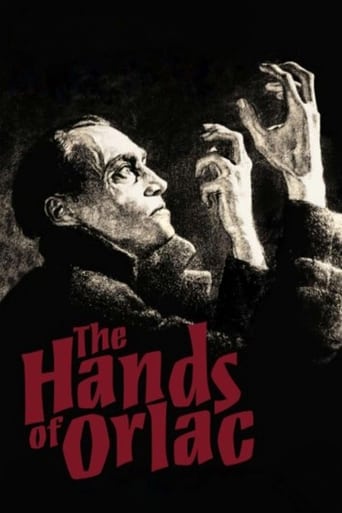Robert J. Maxwell
I realize this movie was a true original. Well, kind of, anyway. Maurice Renard wrote the novel in 1920, and he wrote the original mixed-up transplant novel in 1908 about organs being transplanted not just from human to human but to animals, plants, and even machines. One wonders what it must have been like to be Maurice Renard's room mate. But, in fact, maybe the whole business began with Mary Shelley's "Frankenstein" and lasted at least through the latest version of "The Fly" and "Robocop." Anyway, yes, I realize the film is an original and that it was directed by the same guy, Robert Wiene, who had earlier given us "The Cabinet of Dr. Caligari," which I truly believe was dreamed up on some kind of amusement park ride.But, man, this is one slow slog. Example: Conrad Veidt as Orlac has discovered his hands have been transplanted from a murderer and he sits brooding on the couch. Behind him stands his wife, Alexandra Sorina, staring at him without his realizing that she's there. I tried to time the motionless scene in which she stares at his back and he sits, but my LED clock was in shadow and I couldn't read it. It must be thirty full seconds. Nothing happens. Finally she drops -- verrry slowwwly -- to her knees and creeps towards him until she's able to nuzzle his hand. Veidt jerks it away in disgust.I hate modern movies that are stylishly edited so that each shot lasts a fraction of a second, but this was like watching actors move inside a huge vat of corn syrup. Sorina overacts too. Everybody is expected to overact in a silent movie but this goes a bit over the edge. Veidt, the central figure, has a handle on his role and projects emotions exquisitely. The doctor too reins himself in, though that doesn't stop him from looking like a chump from the Keystone Cops.There's none of the loop-the-loop quality of "Dr. Caligari." There aren't any surprises in the set dressing or the story itself, once we get the picture. Although it's dark, it's been beautifully photographed. Superb use is made of lights in night-for-night shots. The musical score is hard to assess. It sounds like The World Saxophone Quartet for strings, full of extended shimmering dissonant chords and occasional weird shrieks and squeaks. I kind of enjoyed it.It was more or less remade ten years later as "Mad Love" with Peter Lorre in the role of a crazed doctor who performs the transplants. The victim is treated coincidentally. "Mad Love" goes nuts at the end. At least this one is grounded, given the initial fantastic premise.But, mind you, it IS slow.
mhesselius
I've been looking for a DVD of THE HANDS OF ORLAC ever since I knew the film existed. Now it's finally here, and like most silent films it's a mixed bag. I find the image on the new KINO disc to be acceptable considering the problematic nature of the source material. There's a loss of definition in some scenes, but there are also moments of sharpness in the restored Murnau Foundation print. It's a shame we can never experience non-talking films the way 1920s audiences did, without washed-out contrasts, image-flickers, frame-jitters, dirt, and print damage. Even the best restorations don't look new.The plot concerns a concert pianist whose hands are smashed in a train wreck. A surgeon replaces them with the hands an executed criminal. Soon the pianist is obsessed with thoughts he might be a killer. The performances are generally excellent in the Expressionistic style. Conrad Veidt's exaggerated grimacing as his character Paul Orlac approaches madness is tempered by moments that are extremely moving.The score of mostly string music on the KINO disc is creepy and works well for a while, but is so monotonous over the entire length of an already ponderously paced film that I grew tired of it. This film cries out for music that varies its mood to fit what is happening on screen. Contrasts in the mood of the music would make the creepy parts seem even creepier. An optional score in a traditional style would have been nice. Nevertheless, the Gothic set design and shadow-infested cinematography by Gunther Krampf - particularly the scenes at Orlac's father's house - create the atmosphere we know and love in early horror films. These chiaroscuro light-and-shadow effects just cannot be achieved with color.However, to evoke fear without the modern cheats of gore and violence - to create what the Germans call "stimmung" (mood) - requires not only imaginative lighting and set design, but time. Unfortunately director Robert Weine spends too much time on the actors' very deliberate expressionistic movements at the expense of pacing.The ending is likewise unsatisfactory, although it does follow Maurice Renard's novel. I won't give too much away other than to say the ending undercuts an apparently fantastic element, yet makes the "logical" explanation seem almost as implausible. Nevertheless, the build-up to the resolution as well as Veidt's engrossing performance makes this a worthwhile, if uninspired, film.
CaligulaAzrael
I must say I was pretty disappointed while watching this one. It's one of the classic movies from the age of German Expressionism, but I cannot call this a masterpiece. Wiene was a director of remarkable "Kabinett des Doktor Caligari" and "Orlacs Hände" doesn't seem to be as successful as this great picture. The action is quite interesting, acting is very good, idea is inspiring but it's also very naive. Specially the ending was too childish and I found myself hard to believe in it. But, I should also admit that Wiene's movie has some kind of intriguing atmosphere, which makes the whole thing worth watching. If you're enthusiastic to German cinema of the decade you should watch this one, but don't expect too much.
MartinHafer
THE HANDS OF ORLAC is an exceptional German silent film and was remade in Hollywood just a few years later as MAD LOVE (starring another German, Peter Lorre). Both are well worth seeing, as they are quite different in how they portray the leading character.The film begins with a pianist (Conrad Veidt) having his hands tragically severed in an accident. However, in an amazing bit of surgery, the hands of an executed man are grafted seamlessly onto Orlac. Oddly, however, the pianist is haunted by the ghost of this dead man and the hands seem to have a mind of their own--with a strong desire to kill!! During all this film, Veidt overacts horribly--even for a silent film. In many ways, he acts much like the main character from THE CABINET OF DR. CALIGARI--a famous German Expressionist film made almost a decade earlier. For a 1919 film, this wasn't a problem, but by 1924 this sort of acting was becoming a bit passé. While not bad, you can't deny that he over-emotes here and there.Despite this over-emoting, the film is quite exciting and well-paced. The horror film has some wonderful twists and turns that keep the audience guessing and the excitement never lets up until the very end. One of the better silent films and fortunately the DVD print is top quality.






